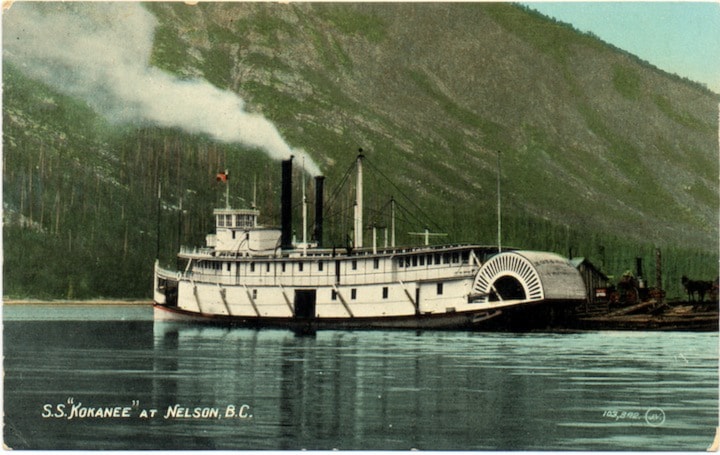One hundred and fourth in an alphabetical series on West Kootenay/Boundary place names
In addition to being a fish and a popular beer, kokanee is the name of 14 geographic features in BC: a settlement, bay, creek, two provincial parks, glacier, recreation area, lake, landing, narrows, pass, peak, point, and range.
As a result, it’s probably this area’s most widely used indigenous word. Kokanee is derived from kekeni, the Sinixt term for the landlocked salmon once plentiful in this region. (There’s no need to capitalize kokanee when referring to the fish, although many people do anyway.)
However, when Europeans first adopted the word, they didn’t know its definition. The earliest reference in the Nelson Miner of June 15, 1895 said: “The jagged ridge visible from Nelson away up the lake to the North-East is Ko-ko-nee, of the meaning of which we are sorry to say, we are ignorant.”
The present spelling was adopted the following year when the Columbia and Kootenay Steam Navigation Co. launched the SS Kokanee on Kootenay Lake. The Trail Creek News of March 21, 1896 explained the name was “after the range of mountains near Nelson.”
Kokanee Creek, also known as Yuill Creek, was so named by October 1896 and a townsite called Kokanee was laid out at its head, adjoining the Molly Gibson mine. The Sandon Paystreak of Aug. 14, 1897 kidded that “its inhabitants, when they become numerous enough to need a name, will be called the Kokakanucks.”
Kokanee Glacier was first called by that name in The Ledge of June 17, 1897. After climbing the glacier in the fall of 1898, mining promoter Ernest Mansfield renamed it after Lord Kitchener, but following his departure from the area in 1901, it reverted to Kokanee.
Near the spot that the creek emptied into the lake was Kokanee Landing, first mentioned in the Nelson Tribune of April 9, 1899. The earliest known reference to kokanee meaning the fish was in a promotional booklet produced in late 1899 or early 1900 called Health and Wealth: Kaslo, BC: “During summer months in many streams emptying into Kootenay Lake, spearing a peculiar red fish of the trout species, called by the Indians ‘Kokanee’ is quite an amusement. Long strings of these are frequently seen.”
Somewhere along the West Arm of Kootenay Lake — probably at Lasca Creek, directly opposite Kokanee Creek — was what the Sinixt called Yaksakukeni: place of many kokanee. However, it was many more years before kokanee was commonly used by European settlers to refer to the fish.
Two Kokanee post offices existed, the first apparently at the townsite, from 1902-11, and another at the landing, from 1911-15.
But what made kokanee a household word beyond West Kootenay was a conversation between Nelson mayor Tom Shorthouse and H.F. Puder of Interior Breweries in 1959 about the company’s recent move from Nelson to Creston. Shorthouse pointed to the potential of Kokanee Glacier Park — created in 1922 — as a tourist attraction and suggested the company name a beer brand Kokanee.
“This thought really stuck,” Puder told Shorthouse a year later, “and the more the name ‘Kokanee’ was considered, the better we liked it … To you goes full credit for originating the idea and you may be assured that you will be among the first to sample the product.”
Kokanee pilsner beer first appeared in the spring of 1960 with a label featuring a painting of the glacier by Vancouver designer George McLachlan. While the artwork has changed over the years, it continues to use a glacier motif and remains one of BC’s best-selling brands.
The name has since spread far and wide. Lots of businesses adopted the name — including Kokanee Springs golf resort. There’s a Kokanee Bay in the Cariboo; a Kokanee elementary school near Seattle; and streets named Kokanee in Nelson, Cranbrook, Vancouver, Whitehorse, Ontario, Washington, Idaho, Montana, Oregon, Colorado, California, and New Mexico.
Most of these were presumably taken out of atlases and don’t have anything to do with our area, but there’s a Kokanee Bend fishing area in Montana.
Previous installments in this series
Applegrove, Appleby, and Appledale revisited
Bakers, Birds, and Bosun Landing
Bannock City, Basin City, and Bear Lake City
Bealby Point (aka Florence Park) revisited
Boswell, Bosworth, Boulder Mill, and Broadwater
Brooklyn, Brouse, and Burnt Flat
Camborne, Cariboo City, and Carrolls Landing
Carmi, Cedar Point, Circle City, and Clark’s Camp
Carson, Carstens, and Cascade City
Christina City and Christian Valley
Cody and Champion Creek revisited
Champion Creek revisited, again
Columbia City, Columbia Gardens, and Columbia Park
Crawford Bay and Comaplix revisited
Dawson, Deadwood, and Deanshaven
English Cove and English Point
Forslund, Fosthall, and Fairview
Fort Shepherd vs. Fort Sheppard, Part 1
Fort Shepherd vs. Fort Sheppard, Part 2
Gladstone and Gerrard, revisited
Granite Siding and Granite City
Hall Siding and Healy’s Landing
Hudu Valley, Huntingtdon, and Healy’s Landing revisited
Inonoaklin Valley (aka Fire Valley)
